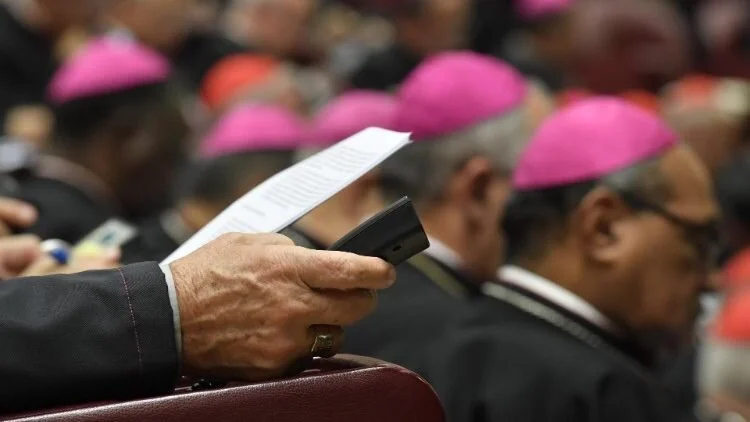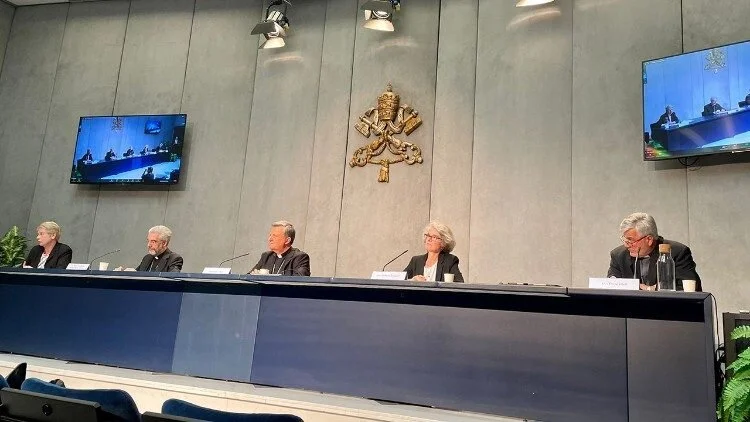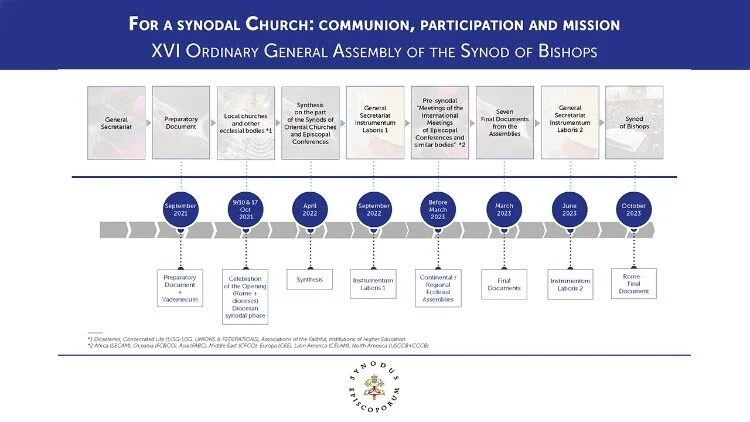Listening to the Faithful: Vatican releases Synod Preparatory Document
This article is also available in Arabic.
File photo from the 2019 Synod of Bishops (Vatican Media)
The General Secretariat for the Synod of Bishops presents the base text and “vademecum” – or handbook – to guide the journey of the Synod on Synodality.
By Salvatore Cernuzio
Listening without prejudice; speaking out with courage and parrhesia; dialoguing with the Church, with society, and with the other Christian confessions.
The General Secretariat for the Synod has published the Preparatory Document, along with a Vademecum (or handbook) to indicate the guiding principles that will direct the path of the Synod on Synodality. The solemn opening of the Synod will take place in Rome on October 9-10, and in the particular Churches on October 17; and will conclude in the Vatican in 2023 with the assembly of bishops from around the world.
The Preparatory Document, released on Tuesday, is intended above all to be an instrument facilitating the first phase of listening and consultation of the People of God in the particular Churches, which will take place from October 2021 to April 2022.
Press conference introducing the Preparatory Document
Journeying together
“In other words,” as the document says, “it constitutes a sort of construction site or pilot experience that makes it possible to immediately begin reaping the fruits of the dynamic that progressive synodal conversion introduces into the Christian community.”
The text opens with a fundamental question:
"How does this ‘journeying together,’ which takes place today on different levels (from the local level to the universal one), allow the Church to proclaim the Gospel in accordance with the mission entrusted to Her; and what steps does the Spirit invite us to take in order to grow as a synodal Church?"
The stages of the synodal journey
Steps towards synodality
To respond to this question, the Secretariat of the Synod points out some concrete steps. First of all, it is necessary to live “a participative and inclusive ecclesial process that offers everyone—especially those who for various reasons find themselves on the margins—the opportunity to express themselves and to be heard”; and then to recognize and appreciate “the wealth and the variety of the gifts and charisms that the Spirit liberally bestows… for the benefit of the whole human family.”
Further, it is necessary to examine “how responsibility and power are lived in the Church, as well as the structures by which they are managed, bringing to light and trying to convert prejudices and distorted practices that are not rooted in the Gospel.”
The document invites us to look at how the Christian community can be accredited “as a credible subject and reliable partner in paths of social dialogue, healing, reconciliation, inclusion and participation, the reconstruction of democracy, the promotion of fraternity and social friendship”; as well as how we can regenerate relationships among Christians, with representatives of other Christian confessions, and with other social groups, with the organizations of civil society, and with popular movements.
These concrete steps will take place “within an historical context marked by epochal changes in society,” beginning with the “global tragedy” of the Covid-19 pandemic, which has led pre-existing inequalities and injustices “to explode.” At the same time, the document recognizes that the synodal process is being undertaken in which “the Church herself must face the lack of faith and the corruption even within herself,” emphasizing that “we cannot forget the suffering experienced by minors and vulnerable people ‘due to sexual abuse, the abuse of power, and the abuse of conscience” committed by clergy.
However, “it is precisely in the furrows dug by the sufferings of every kind,” the document continues, that “new languages of faith” and “new paths” flourish, in order to found anew “the path of Christian and ecclesial life.” These are occasions to offer ample space for renewed participation and appreciation of the laity, and especially of women and young people, as requested by recent Synods.
Active evangelizers
With regard to the laity, the document reiterates that all the baptized “are active participants in evangelization”; and so it is essential that on the synodal path, pastors “not be afraid to listen to the Flock entrusted to them.”
In a synodal Church, it insists, quoting Pope Francis, everyone – “the faithful, the bishops, and even the Bishop of Rome himself” – has something to learn, “all listening to each other, and all listening to the Spirit of truth.” This includes a call to deepen our relationship with other Christian communities. “A synodal Church,” it says, “is a prophetic sign, above all for a community of nations incapable of proposing a shared project, through which to pursue the good of all.”
More concretely, the preparatory text proposes a series of questions to guide the consultation with the People of God, beginning with the fundamental question:
"How is this 'journeying together' happening today in your particular Church?"
It is necessary, therefore, to ask what experiences in one’s own diocese this question brings to mind: “What joys did they provoke? What difficulties and obstacles have they encountered? What wounds have they brought to light?... What are the prospects for change, and the steps to be taken?”
Levels of synodality
The document goes on to explain three levels of synodality: “the level of the style with which the Church ordinarily lives and works… the level of ecclesial structures and process… [and] the level of synodal processes and events in which the Church is convoked by competent authority.” These three levels of articulation of synodality are distinct, but “must be held together in a coherent way; otherwise, a counter-testimony is transmitted, and the Church’s credibility is undermined.”
In this evaluation of experiences, account must also be taken in the particular Church of the internal relations between the faithful, pastors, parishes, and communities; but also between the bishops (among themselves and with the Pope), and with the intermediate bodies …
This article was originally published on Vatican News website. Please click here to read the full text.



